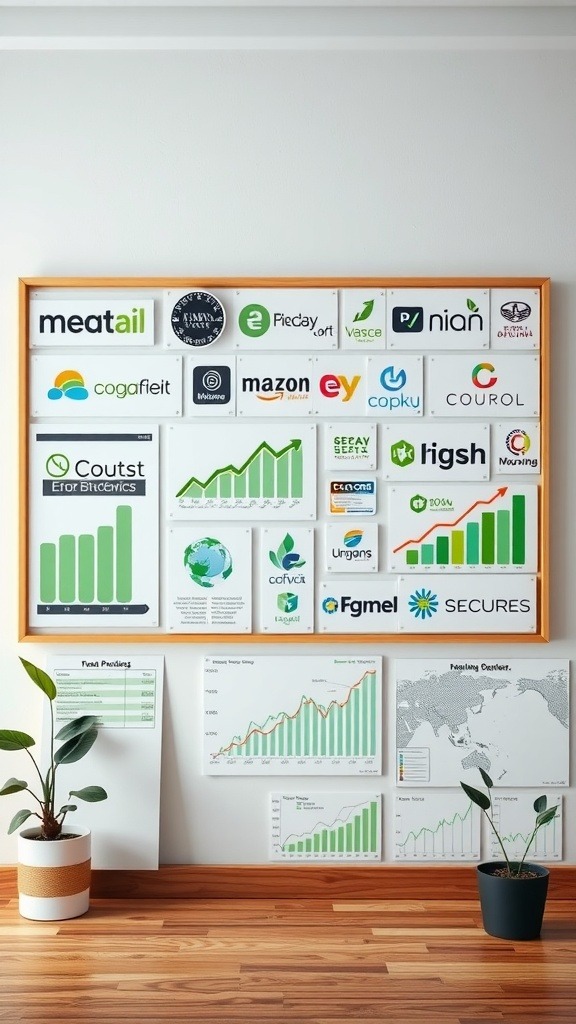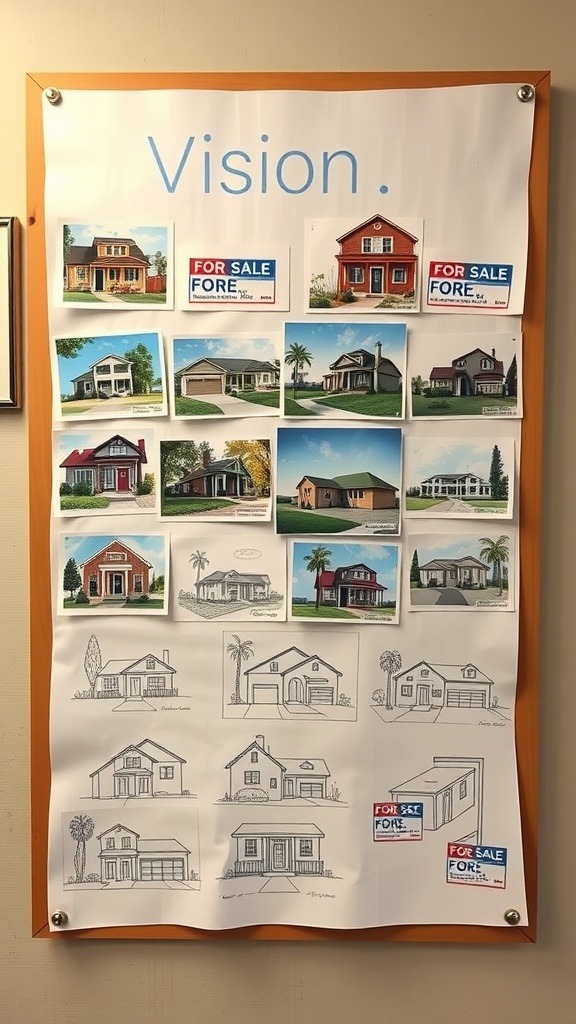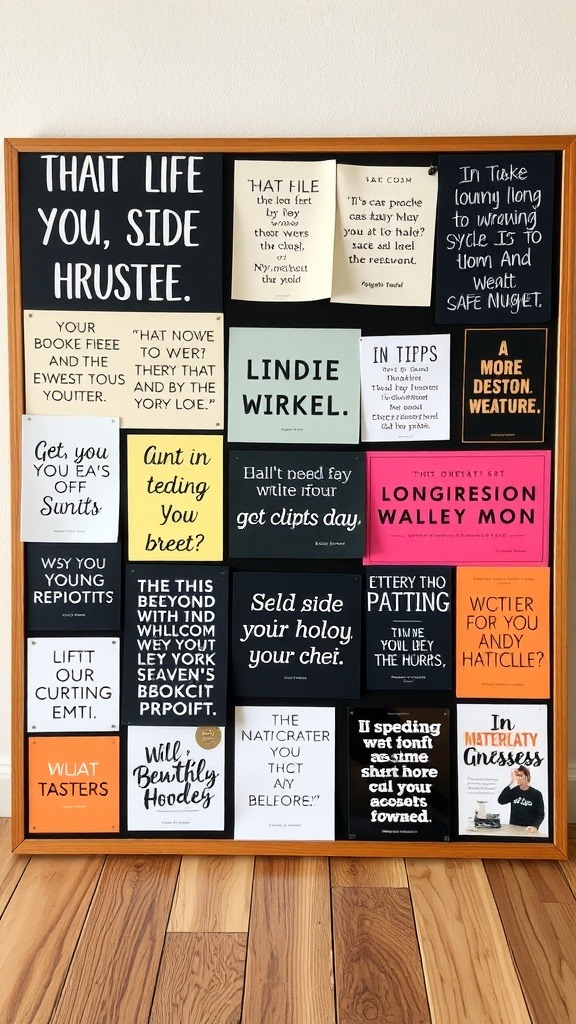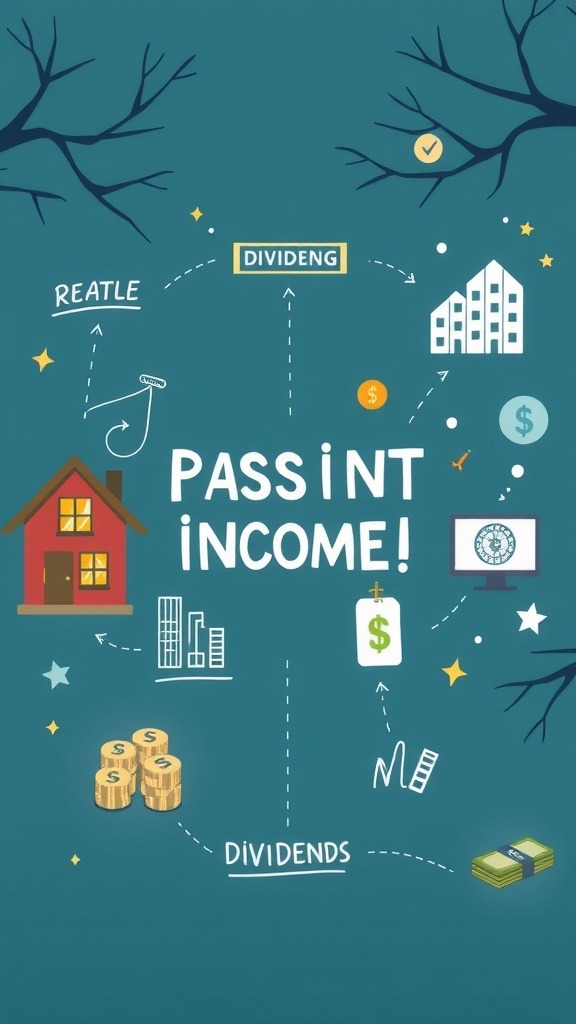
Want to make some extra cash in 2025? Vision boards can be a fun and effective way to map out your financial goals. From side hustles to investments, we’ve got 20 creative vision board ideas that can inspire your journey towards making money. Let’s jump right in and explore ways to visualize your financial future!
A vision board is a collage of images and words that represent your goals, dreams, and aspirations.
1. Investing in Sustainable Stocks

Investing in sustainable stocks is a smart way to grow your wealth while supporting eco-friendly companies.
Look for businesses with strong commitments to sustainability and social responsibility.
This not only helps the planet but can also lead to impressive returns in the long run.
Here are 10 expanded ideas for your Vision Board for Investing in Sustainable Stocks
Sustainable Investment Goals – Define your financial targets, such as long-term wealth building or supporting ethical businesses.
Research Sustainable Companies – Include visuals of top-performing ESG (Environmental, Social, Governance) companies and industries like renewable energy and clean technology.
Portfolio Diversification – Visualize a balanced mix of sustainable stocks across sectors such as energy, healthcare, and technology.
Impact Measurement – Track the environmental and social impact of your investments using ESG ratings and sustainability reports.
Investment Strategy Plan – Outline strategies such as dollar-cost averaging or dividend reinvestment plans.
Risk Management – Include reminders to assess risk factors, such as market volatility and regulatory changes, within sustainable investing.
Educational Resources – Add books, podcasts, and courses on ethical investing to stay informed and improve your knowledge.
Financial Milestones – Set savings and return-on-investment goals to track your progress toward financial independence.
Dividend & Growth Projections – Visualize potential returns and how they align with your sustainability and income goals.
Personal Motivation – Include quotes and images that remind you why investing in sustainable companies aligns with your values and long-term vision.
2. Exploring Real Estate Opportunities

Creating a vision board focused on real estate can help you visualize your investment goals.
Include images of homes you dream of buying or renovating to attract potential buyers.
This clear imagery can keep you motivated and focused on making those real estate opportunities happen in 2025.
Here are 10 expanded ideas for your Vision Board for Exploring Real Estate Opportunities:
- Investment Goals – Define what you aim to achieve, such as passive income, long-term appreciation, or flipping properties.
- Market Research – Include visuals of top-performing real estate markets and trends to identify high-potential areas.
- Property Types – Explore different options like residential, commercial, vacation rentals, or multi-family properties.
- Financing Strategies – Outline mortgage options, investment loans, and budgeting plans for property acquisition.
- Risk Management – Visualize contingency plans for market fluctuations, property maintenance, and tenant risks.
- Networking Opportunities – Add images of real estate conferences, meetups, and mentors to connect with industry professionals.
- Passive Income Projections – Map out expected rental income and cash flow calculations to stay motivated.
- Property Features Wishlist – Include key property elements such as location, amenities, and potential renovations.
- Legal Considerations – Visualize key regulations, tax benefits, and property management strategies.
- Long-Term Vision – Set future goals like owning multiple properties, diversifying your portfolio, or expanding into international markets.
These ideas will help clarify your real estate investing journey and keep you focused on actionable steps.
3. Freelance Hustle Manifesto

Creating your freelance hustle starts with a vision board that inspires you every day.
Fill it with quotes and images that remind you why you chose this path.
Keep it visible, and let it motivate you to turn your dreams into reality.
Here are 10 expanded ideas for your Vision Board for a Freelance Hustle Manifesto:
- Define Your Niche – Identify your core skills and interests to focus on a specialized area that aligns with your expertise and market demand.
- Client Acquisition Strategy – Visualize ways to attract clients through platforms like Upwork, Fiverr, or networking events.
- Income Goals – Set specific monthly or yearly income targets to track your financial progress and growth.
- Skill Development – Include online courses, certifications, and mentorship programs to enhance your abilities.
- Portfolio Showcase – Plan the layout of an impressive online portfolio with case studies and testimonials.
- Marketing Tactics – Visualize content strategies for social media, blogs, and cold outreach to expand your reach.
- Time Management Techniques – Incorporate tools like time blocking or productivity apps to stay organized.
- Freelance Pricing Strategy – Research competitive rates and visualize your pricing packages for different service levels.
- Networking Opportunities – Add images of industry events, online communities, and collaborations to grow your professional circle.
- Work-Life Balance Plan – Set boundaries, schedules, and self-care routines to avoid burnout while maintaining productivity.
These ideas will help you stay focused and motivated in your freelance journey.
4. Building an Online Course Empire

Creating an online course can be a great way to share your knowledge and make money.
Just think about what you know and how you can package it for others.
Use your vision board to brainstorm ideas and map out your course content!
Here are 10 expanded ideas for your Vision Board for Building an Online Course Empire:
- Course Topic Selection – Visualize your niche based on your expertise and market demand, ensuring it aligns with your passion and audience needs.
- Target Audience Profile – Define your ideal students, their pain points, and learning preferences to create a personalized course experience.
- Content Creation Plan – Outline your course structure, including modules, lessons, and supplementary materials like worksheets and quizzes.
- Marketing Funnel Strategy – Visualize lead generation tactics such as email sequences, webinars, and social media ads.
- Platform Choices – Compare different hosting platforms like Teachable, Udemy, or self-hosted options to choose the best fit.
- Monetization Goals – Set revenue targets, pricing strategies, and upselling opportunities to maximize income.
- Student Engagement Strategies – Include plans for interactive elements like Q&A sessions, private communities, and feedback loops.
- Brand Identity – Visualize your course’s branding with a consistent style, logo, and messaging to create a recognizable presence.
- Testimonial and Success Stories – Add inspirational feedback from beta testers or past students to build credibility.
- Growth and Expansion Plan – Set long-term goals such as scaling with additional courses, partnerships, and international reach.
These ideas will help you build a strategic and successful online course business.
5. Developing a Side Hustle Mindset

A side hustle can bring in extra cash and spark new ideas.
Start by identifying what you love and how you can turn it into an income.
Remember, every successful side hustle begins with a positive mindset and clear goals.
Here are 10 expanded ideas for your Vision Board for Developing a Side Hustle Mindset:
- Clarity on Your ‘Why’ – Visualize the reasons behind your side hustle, such as financial freedom, creative fulfillment, or career advancement.
- Time Management Strategies – Add productivity techniques like time blocking or prioritization frameworks to balance your side hustle with your main job.
- Daily Motivation Reminders – Include motivational quotes, success stories, and affirmations to stay inspired during challenging times.
- Skill Development Goals – Identify key skills you need to develop to enhance your side hustle and stay competitive.
- Financial Milestones – Set achievable income targets and visualize how your side hustle can supplement or replace your main income.
- Support System Visualization – Include mentors, accountability partners, or networking groups to stay motivated and connected.
- Mindset Shifts – Visualize adopting a growth mindset, overcoming fear of failure, and embracing continuous learning.
- Success Stories Inspiration – Add visuals of entrepreneurs or influencers who successfully turned their side hustle into a full-time business.
- Work-Life Balance Goals – Ensure you visualize healthy boundaries to avoid burnout while pursuing your passion.
- Long-Term Vision – Set ambitious yet achievable goals for scaling your side hustle into a sustainable business.
These elements will help cultivate the right mindset for a successful side hustle journey.
6. Vision Board Ideas for Creating a Digital Product Business

Building a digital product business can be a fun way to make money.
Start by brainstorming ideas that excite you, like eBooks or online courses.
Use your vision board to keep your goals in sight and stay motivated!
Here are 10 expanded ideas for your Vision Board for Creating a Digital Product Business:
- Product Idea Validation – Visualize market research, competitor analysis, and potential customer pain points to refine your digital product idea.
- Target Audience Profile – Define your ideal customer’s demographics, needs, and preferences to tailor your product effectively.
- Content Creation Plan – Outline your product structure, including digital courses, eBooks, templates, or software solutions.
- Sales Funnel Strategy – Include visuals of lead generation tactics such as email marketing, landing pages, and social media promotions.
- Platform Selection – Compare platforms like Gumroad, Etsy, or your website for hosting and selling your digital products.
- Branding Elements – Develop a cohesive visual identity with logos, color schemes, and messaging that reflect your product.
- Marketing Roadmap – Plan content marketing strategies, social media campaigns, and influencer collaborations to boost visibility.
- Financial Goals – Set clear revenue targets, pricing structures, and passive income projections to stay motivated.
- Customer Engagement – Include community-building strategies such as feedback loops, webinars, and exclusive groups.
- Scaling Strategies – Visualize long-term goals like expanding product offerings, creating bundles, or reaching new markets.
These ideas will help you create a clear and actionable vision for your digital product business.
7. Vision Board Ideas for Creating an Art or Craft Business

Starting an art or craft business can be a fun way to make money.
Get inspired by your creativity and think about what products you would love to create and sell.
Whether it’s handmade decor or unique gifts, there’s always a market for personal touches!
Here are 10 expanded ideas for your Vision Board for Creating an Art or Craft Business:
- Creative Inspiration – Collect images, textures, and color palettes that inspire your art style and creative direction.
- Product Development – Outline potential product lines such as handmade jewelry, paintings, or customized crafts.
- Brand Identity – Visualize logo ideas, packaging concepts, and branding elements that reflect your unique style.
- Marketing Strategy – Plan social media content, craft fair participation, and influencer collaborations to promote your work.
- E-commerce Platforms – Research and visualize where to sell, such as Etsy, Shopify, or your personal website.
- Pricing Strategies – Include pricing models, cost breakdowns, and competitor analysis to ensure profitability.
- Customer Engagement – Plan community-building efforts like social media engagement and personalized customer experiences.
- Workspace Setup – Design your ideal studio or workspace with organization and efficiency in mind.
- Income Goals – Set financial targets and revenue projections to measure your business growth.
- Long-Term Vision – Visualize future goals such as expanding your product line, teaching workshops, or opening a physical store.
These ideas will help you create a focused and inspiring roadmap for your art or craft business.
8. Vision Board Ideas for Starting a Dropshipping Store

Starting a dropshipping store can be a fun way to make money.
You can sell products without ever touching the inventory.
Just find a niche you love, set up your online shop, and let the sales roll in!
Here are 10 expanded ideas for your Vision Board for Starting a Dropshipping Store:
- Niche Selection – Visualize potential niches based on trends, demand, and competition to find profitable products.
- Winning Product Ideas – Include images of trending and evergreen products that align with your chosen niche.
- Supplier Partnerships – Research and visualize reliable suppliers from platforms like AliExpress or CJ Dropshipping.
- E-commerce Platform Choice – Compare platforms such as Shopify, WooCommerce, or Amazon to find the best fit.
- Marketing Strategy – Plan social media ads, influencer collaborations, and email marketing to drive traffic.
- Branding & Store Design – Develop a cohesive brand identity with logos, color schemes, and a professional website layout.
- Customer Service Strategy – Visualize ways to enhance customer experience, such as chatbot integration and easy returns.
- Financial Goals – Set revenue targets, profit margins, and cost management plans for long-term sustainability.
- Automation Tools – Identify apps and software to streamline order fulfillment, inventory management, and marketing.
- Scaling Strategies – Visualize growth plans such as expanding product lines, entering new markets, or launching paid ad campaigns.
These elements will help guide you in building a successful and scalable dropshipping business.
9. Launching a Subscription Box Service

Starting a subscription box service is a fun way to tap into a growing market. You can curate unique items that match your audience’s interests and deliver them right to their doorsteps. This idea not only brings a steady income but also creates a community around your brand.
Here are 10 expanded ideas for your Vision Board for Launching a Subscription Box Service:
- Niche Selection – Visualize potential themes such as beauty, fitness, or gourmet foods that cater to your target audience.
- Ideal Customer Persona – Define your audience demographics, preferences, and purchasing behavior to tailor your box offerings.
- Product Sourcing Strategy – Research potential suppliers and curate high-quality items that align with your subscription theme.
- Brand Identity – Include logo ideas, packaging designs, and messaging to create a visually appealing and cohesive brand.
- Pricing Model – Visualize different subscription tiers, pricing strategies, and value propositions to attract customers.
- Marketing Plan – Map out content strategies, influencer partnerships, and social media promotions to increase visibility.
- Customer Experience Goals – Plan for unboxing experiences, personalized touches, and loyalty programs to retain subscribers.
- Logistics & Fulfillment – Visualize partnerships with fulfillment centers and shipping providers to ensure smooth delivery.
- Revenue Milestones – Set short-term and long-term income goals to track business growth and profitability.
- Growth & Expansion – Plan future goals such as adding new product categories, entering new markets, or offering exclusive partnerships.
These ideas will help you create a clear and actionable vision for your subscription box service.
10. Exploring Cryptocurrency Investments

Thinking about cryptocurrency investments?
It’s a great idea to include this on your vision board for 2025.
With so many options out there, you can find the right fit for your financial goals!
Here are 10 expanded ideas for your Vision Board for Exploring Cryptocurrency Investments:
- Investment Goals – Define short-term and long-term goals, such as portfolio diversification, passive income, or high-risk growth opportunities.
- Cryptocurrency Portfolio – Visualize a diversified portfolio including Bitcoin, Ethereum, altcoins, and stablecoins for balanced growth.
- Market Research Sources – Add reliable sources like news websites, influencers, and analytics platforms to stay informed on market trends.
- Risk Management Strategies – Outline risk tolerance levels, stop-loss plans, and diversification strategies to minimize losses.
- Trading vs. Holding – Visualize different strategies such as day trading, swing trading, or long-term holding based on your risk appetite.
- Security Measures – Include steps for securing assets, such as using hardware wallets, two-factor authentication, and secure exchanges.
- Passive Income Opportunities – Explore staking, yield farming, and liquidity pools to generate additional income.
- Tax Planning – Visualize tax obligations and compliance strategies to avoid legal issues with cryptocurrency earnings.
- Learning Milestones – Set educational goals such as understanding blockchain technology, DeFi (Decentralized Finance), and NFTs.
- Exit Strategies – Plan cash-out strategies, reinvestment options, and emergency liquidation plans for various market conditions.
These ideas will help you stay focused and strategic in your cryptocurrency investment journey.
11. Harnessing the Power of Affiliate Marketing

Affiliate marketing is a great way to earn money while sharing what you love.
By promoting products or services that match your interests, you can make money from your blog or social media.
Get creative with your vision board by including goals for successful partnerships and strategies to boost your income.
Here are 10 expanded ideas for your Vision Board for Harnessing the Power of Affiliate Marketing:
- Niche Selection – Identify a profitable niche that aligns with your interests and expertise, such as tech gadgets, fitness, or finance.
- Affiliate Programs – Research and visualize top affiliate programs like Amazon Associates, ShareASale, or niche-specific partnerships.
- Content Creation Plan – Outline strategies for blog posts, social media content, and video reviews to promote affiliate products.
- Traffic Generation Strategies – Visualize methods such as SEO, paid ads, and social media marketing to drive targeted traffic.
- Email Marketing Funnel – Plan a lead generation strategy with opt-ins, automated sequences, and personalized recommendations.
- Performance Metrics – Set goals for click-through rates, conversion rates, and commission earnings to track progress.
- Branding Strategy – Develop a personal brand that establishes trust and authority in your niche.
- Passive Income Goals – Visualize potential monthly earnings and scaling strategies for long-term profitability.
- Learning Resources – Include books, courses, and mentorship programs to stay updated on industry trends and best practices.
- Scaling Strategies – Plan future growth by expanding to multiple platforms, collaborating with influencers, and automating processes.
These ideas will help you create a strategic and actionable approach to affiliate marketing success.
12. Developing a Personal Finance Blog

Starting your own personal finance blog can be a fun way to share your money tips.
Use tools and resources to help you create content that resonates with readers.
Focus on real-life experiences to inspire others on their financial journeys.
Here are 10 expanded ideas for your Vision Board for Developing a Personal Finance Blog:
- Niche Definition – Identify your blog’s focus, such as budgeting, investing, debt management, or frugal living.
- Content Strategy – Plan blog topics, publishing schedules, and evergreen content ideas to keep readers engaged.
- Monetization Goals – Visualize revenue streams like affiliate marketing, sponsored content, and digital product sales.
- SEO Plan – Outline keyword strategies, backlink goals, and on-page SEO tactics to increase visibility.
- Branding Elements – Design your blog’s logo, color scheme, and tone to establish a recognizable brand.
- Social Media Promotion – Plan content for platforms like Pinterest, Instagram, and Twitter to drive traffic.
- Audience Engagement – Visualize community-building efforts through email newsletters, forums, and Q&A sessions.
- Income Milestones – Set achievable revenue targets and track growth over time.
- Learning Resources – Include courses, webinars, and financial books to stay informed and provide value.
- Long-Term Vision – Plan future goals such as expanding into coaching, launching a podcast, or writing a book.
These ideas will help you build a successful and engaging personal finance blog.
13. Vision Board Ideas for Building a Personal Brand

Creating a personal brand is a fun way to express who you are and what you stand for.
Use your vision board to highlight your unique qualities and goals.
Choose visuals that inspire you and reflect your journey towards success.
Here are 10 expanded ideas for your Vision Board for Building a Personal Brand:
- Core Values & Mission Statement – Define what you stand for and your unique value proposition to guide your branding efforts.
- Target Audience Profile – Visualize your ideal audience, their interests, and the problems you aim to solve for them.
- Visual Branding Elements – Include logos, color schemes, typography, and imagery that reflect your personality and niche.
- Content Strategy – Plan key content types such as blogs, videos, and social media posts to establish authority.
- Online Presence Goals – Set milestones for website creation, social media growth, and community engagement.
- Networking & Collaborations – Add opportunities for connecting with influencers, mentors, and industry leaders.
- Personal Growth Goals – Include skills you want to develop, such as public speaking or writing, to strengthen your brand.
- Social Proof – Visualize testimonials, media features, and case studies to build credibility.
- Income Streams – Plan monetization strategies such as consulting, sponsorships, and online courses.
- Long-Term Vision – Set ambitious goals like book publishing, speaking engagements, or expanding your influence globally.
These ideas will help create a focused and impactful personal brand.
14. Curating an Online Thrift Store

Starting an online thrift store is a fun way to make some extra cash.
You can curate unique pieces that tell a story while keeping your space clutter-free.
Plus, it’s a great chance to get creative with your marketing and connect with fellow vintage lovers!
Here are 10 expanded ideas for your Vision Board for Curating an Online Thrift Store:
- Niche Selection – Define your store’s focus, such as vintage clothing, designer resale, or sustainable fashion.
- Brand Identity – Visualize logos, color palettes, and unique aesthetics to create a cohesive and recognizable brand.
- Product Sourcing Strategy – Plan how to acquire inventory through thrift stores, estate sales, and bulk purchases.
- E-commerce Platform – Choose and visualize platforms like Etsy, Depop, or your website to showcase your collection.
- Photography & Presentation – Include ideas for styling, product photography, and descriptions to enhance listings.
- Pricing Strategy – Set pricing tiers based on condition, rarity, and demand for each item category.
- Marketing Plan – Map out strategies using social media, influencer collaborations, and email campaigns to attract customers.
- Sustainability Commitment – Showcase eco-friendly packaging, recycling efforts, and ethical sourcing initiatives.
- Customer Engagement Goals – Plan ways to interact with customers via social media, personalized notes, and loyalty programs.
- Expansion Vision – Set goals for future growth, such as pop-up shops, collaborations, or expanding to international markets.
These ideas will help create a clear roadmap for a successful online thrift store.
15. Engaging in Influencer Marketing

Influencer marketing is a fun way to boost your brand.
Collaborate with popular figures who align with your values and audience.
This can lead to creative campaigns that attract attention and drive sales.
Here are 10 expanded ideas for your Vision Board for Engaging in Influencer Marketing:
- Target Audience Definition – Identify your ideal audience demographics to find influencers who align with your brand values.
- Influencer Research – Curate a list of potential influencers based on niche, engagement rate, and authenticity.
- Campaign Goals – Visualize objectives such as brand awareness, lead generation, or direct sales conversions.
- Content Collaboration Ideas – Brainstorm potential content types like unboxing videos, tutorials, and sponsored posts.
- Budget Planning – Outline spending for influencer partnerships, including commission structures or flat-rate deals.
- Social Media Platforms – Choose where to focus, such as Instagram, TikTok, or YouTube, based on audience engagement.
- Brand Messaging – Ensure consistent brand storytelling across influencer content by providing guidelines and key messages.
- Performance Metrics – Set KPIs like impressions, engagement rates, and ROI tracking to measure campaign success.
- Partnership Management – Plan ongoing relationships with influencers through exclusivity deals or long-term collaborations.
- Legal Considerations – Include guidelines on contracts, disclosure policies, and compliance with platform rules.
These elements will help you develop a structured and impactful influencer marketing strategy.
16. Creating a Mobile App

Making a mobile app can be a fun way to generate income.
Start by brainstorming ideas that solve a problem or make life easier for users.
Once you have a concept, sketch out your app’s features and design to bring your vision to life.
Here are 10 expanded ideas for your Vision Board for Creating a Mobile App:
- App Concept & Purpose – Clearly define your app’s mission, key features, and the problem it solves for users.
- Target Audience – Visualize your ideal users, their demographics, and user personas to tailor the app experience.
- User Interface (UI) Design – Include wireframes, color schemes, and design inspirations to create an intuitive experience.
- Technology Stack – Outline the tools, frameworks, and platforms needed for development, such as iOS, Android, or cross-platform solutions.
- Development Milestones – Set key project phases like prototyping, testing, and final deployment.
- Monetization Strategy – Visualize revenue models, such as in-app purchases, subscriptions, or ad placements.
- Marketing Plan – Plan promotional tactics, including influencer partnerships, social media, and app store optimization (ASO).
- Security & Compliance – Ensure measures like data encryption, GDPR compliance, and user privacy policies.
- User Feedback & Testing – Include plans for beta testing, gathering user reviews, and iterating based on feedback.
- Long-Term Vision – Set goals for future updates, expansion features, and scaling opportunities.
These ideas will help you create a focused and actionable plan for your mobile app project.
17. Exploring Passive Income Vision Board Ideas

Passive income ideas can be a game changer for your financial goals.
Think about options like real estate or dividends from stocks to keep your cash flowing without constant effort.
Setting up these income streams now can lead to some serious rewards in 2025!
Here are 10 expanded ideas for your Vision Board for Exploring Passive Income:
- Investment Opportunities – Visualize income streams like dividend stocks, index funds, and real estate rentals.
- Digital Product Sales – Include ideas for selling eBooks, online courses, and printables that generate revenue over time.
- Affiliate Marketing Strategy – Plan content ideas for blogs, YouTube, or social media to promote affiliate products.
- E-commerce Automation – Explore dropshipping and print-on-demand stores that require minimal hands-on involvement.
- Real Estate Investments – Add goals for rental properties, real estate crowdfunding, and REITs (Real Estate Investment Trusts).
- Licensing & Royalties – Consider opportunities to earn passive income from intellectual property such as photos, music, or patents.
- Automated Side Hustles – Visualize ideas like vending machines, ATM businesses, or self-service kiosks.
- Savings & Interest Income – Set goals for high-yield savings accounts, bonds, and compounding interest growth.
- Peer-to-Peer Lending – Research platforms that allow you to earn interest by lending money to individuals or businesses.
- Long-Term Passive Income Goals – Define success milestones, such as reaching a specific monthly passive income target.
These ideas will help you build a structured and diversified passive income strategy.
18. Establishing an E-commerce Site

Starting your own e-commerce site is a great way to make money.
Choose a niche that excites you and think about how you can make it stand out.
With the right planning and creativity, you can turn your vision into a successful online business.
Here are 10 expanded ideas for your Vision Board for Establishing an E-commerce Site:
- Niche Selection – Identify a profitable niche based on market demand and personal interests to guide product selection.
- Product Sourcing – Visualize potential suppliers, manufacturers, or dropshipping partners to build your inventory.
- Brand Identity – Plan your website’s logo, color scheme, and unique value proposition to establish a strong online presence.
- E-commerce Platform Choice – Research and visualize platforms like Shopify, WooCommerce, or BigCommerce that suit your needs.
- Website Design Layout – Include inspiration for user-friendly, visually appealing site layouts with smooth navigation.
- Marketing Strategies – Outline digital marketing efforts like SEO, PPC ads, and social media campaigns to drive traffic.
- Payment & Shipping Solutions – Plan secure payment gateways and efficient shipping options to enhance customer experience.
- Customer Retention Tactics – Visualize loyalty programs, email marketing, and customer service improvements.
- Financial Goals – Set realistic revenue targets and profit margins to measure business growth.
- Growth & Expansion Plan – Define future goals such as expanding product lines, global shipping, or adding new sales channels.
These ideas will help you create a structured and actionable roadmap for your e-commerce success.
19. Vision Board Ideas for Starting a Consulting Business

Starting a consulting business can be a rewarding way to make money in 2025.
Focus on your skills and areas where you can help others.
Create a vision board to outline your goals and strategies for attracting clients.
Here are 10 expanded ideas for your Vision Board for Starting a Consulting Business:
- Defining Your Expertise – Identify your niche and key strengths, such as business strategy, marketing, or personal development.
- Ideal Client Profile – Visualize your target clients, their challenges, and how your consulting services can provide solutions.
- Brand Development – Plan your consulting brand’s visual identity, including logos, website design, and messaging.
- Service Offerings – Outline various consulting packages, pricing models, and value propositions.
- Marketing Strategies – Include networking opportunities, social media outreach, and thought leadership strategies to attract clients.
- Client Acquisition Goals – Set milestones for securing your first clients and scaling through referrals.
- Sales Funnel Blueprint – Visualize the customer journey from discovery to onboarding and long-term engagement.
- Skill Enhancement – Identify courses, certifications, and mentorship programs to sharpen your consulting skills.
- Financial Planning – Establish revenue goals, budgeting plans, and profitability targets.
- Long-Term Vision – Map out future goals such as expanding your services, hiring a team, or creating passive income streams.
These ideas will help create a structured and strategic approach to launching your consulting business.
20. Developing Financial Literacy Workshops

Creating financial literacy workshops is a great way to share knowledge and help others improve their money skills.
By focusing on practical tips and engaging activities, you can make learning about finances fun and impactful.
These workshops can attract a diverse group of participants eager to enhance their financial literacy and boost their income potential.
Here are 10 expanded ideas for your Vision Board for Developing Financial Literacy Workshops:
- Workshop Topics – Visualize key subjects such as budgeting, investing, credit management, and saving strategies.
- Target Audience – Define your ideal participants, such as students, professionals, or retirees, and tailor content to their needs.
- Educational Resources – Plan materials like worksheets, presentations, and online tools to enhance learning.
- Marketing Plan – Outline promotional strategies using social media, partnerships, and community outreach.
- Engagement Strategies – Include interactive activities such as Q&A sessions, group discussions, and real-life case studies.
- Partnership Opportunities – Visualize collaborations with schools, businesses, and financial institutions for workshop expansion.
- Revenue Model – Consider different pricing options, sponsorship opportunities, and potential grant funding.
- Workshop Format – Plan whether sessions will be in-person, virtual, or hybrid to maximize accessibility.
- Success Metrics – Set goals for attendance, participant feedback, and measurable financial improvements.
- Long-Term Vision – Map out future growth opportunities, such as launching online courses or expanding nationwide.
These ideas will help structure and grow your financial literacy workshop effectively.
Conclusion for Vision Board Ideas
Creating a vision board is a powerful way to bring your financial goals to life. By visualizing your aspirations, you are constantly reminded of what you’re working towards, keeping you motivated and focused. Whether you choose a digital or physical format, the key is to personalize your board with meaningful images, affirmations, and actionable steps that align with your ambitions.
Remember, a vision board is not just a collage—it’s a tool for manifestation and goal-setting. Take time to review and update your board regularly, celebrate your progress, and stay committed to your income-boosting journey. With consistency, creativity, and a clear vision, 2025 could be your most successful year yet!
Start building your vision today and watch your dreams turn into reality.
Also see our Blogposts on Make Money Online in 2025 and on Pinterest and Instagram
